Abstract
We collected 103 clinical Enterococcus faecium isolates from across Canada, performed standard broth microdilution susceptibility testing, and compared these results with results from the MicroScan Pos MIC Type 6 panel (Baxter Health Care Corp., West Sacramento, Calif.) and the AMS-Vitek Gram-Positive Susceptibility card (Vitek Inc., St. Louis, Mo.). High-level aminoglycoside resistance to gentamicin and streptomycin was detected by a single-concentration agar method with 1,000 micrograms of each aminoglycoside per ml. In addition, we tested the effect of the lower calcium content in broth media as recommended in National Committee for Clinical Laboratory Standards (NCCLS) guideline M7-A2 on the activity of the highly calcium-dependent agent daptomycin. Of the 103 E. faecium isolates, there were 4 and 30 isolates with high-level gentamicin resistance (HLGR) and high-level streptomycin resistance (HLSR), respectively. An additional 39 (37 with HLGR and 36 with HLSR) E. faecium isolates were tested by both the MicroScan and the AMS-Vitek systems. The AMS-Vitek card demonstrated sensitivities of 95 and 82% for detecting HLGR strains and HLSR strains, respectively. The MicroScan panel demonstrated improved sensitivities for detecting HLGR (42 to 97%) and HLSR (64 to 84%) when readings were performed manually instead of being generated automatically. Ampicillin resistance (MIC, greater than or equal to 16 micrograms/ml) was detected in 23 of the 103 E. faecium isolates. Only 14 and 20 of these were detected by the MicroScan panels and AMS-Vitek cards, respectively. beta-Lactamase activity was not detected in any isolates. The lower calcium content in broth media recommended by NCCLS guideline M7-A2 markedly reduced the in vitro activity of daptomycin against Enterococcus spp.
Full text
PDF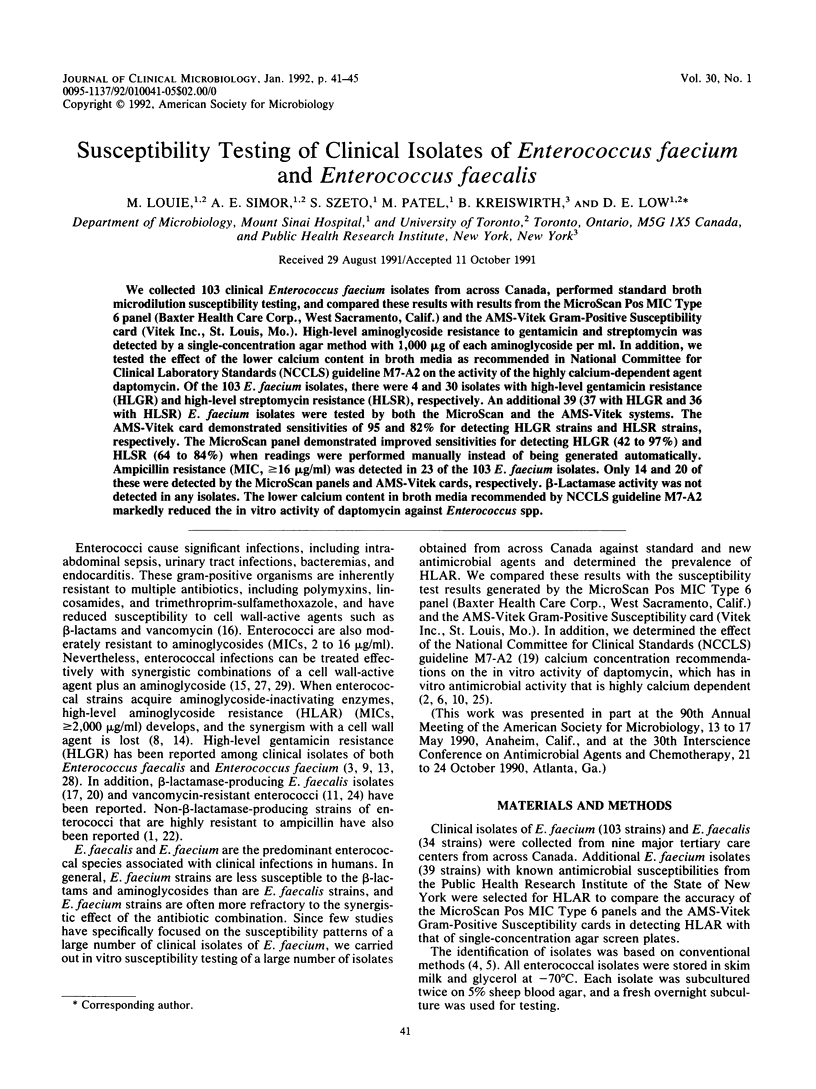
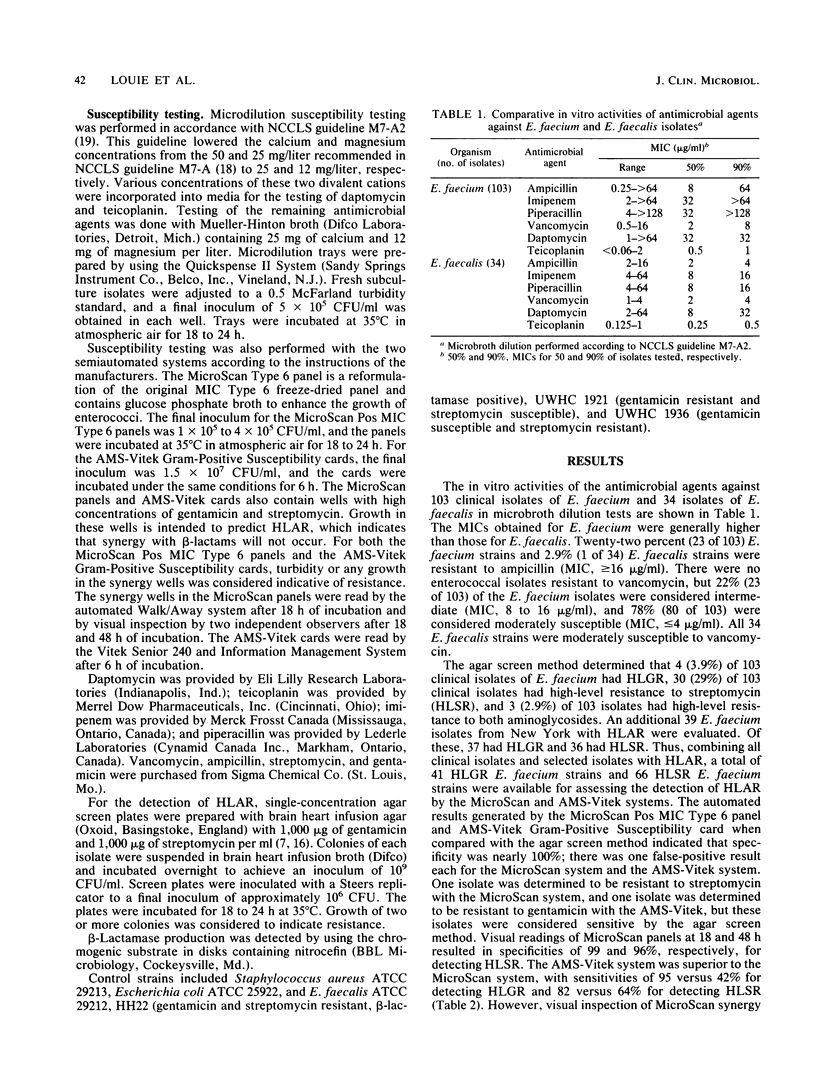
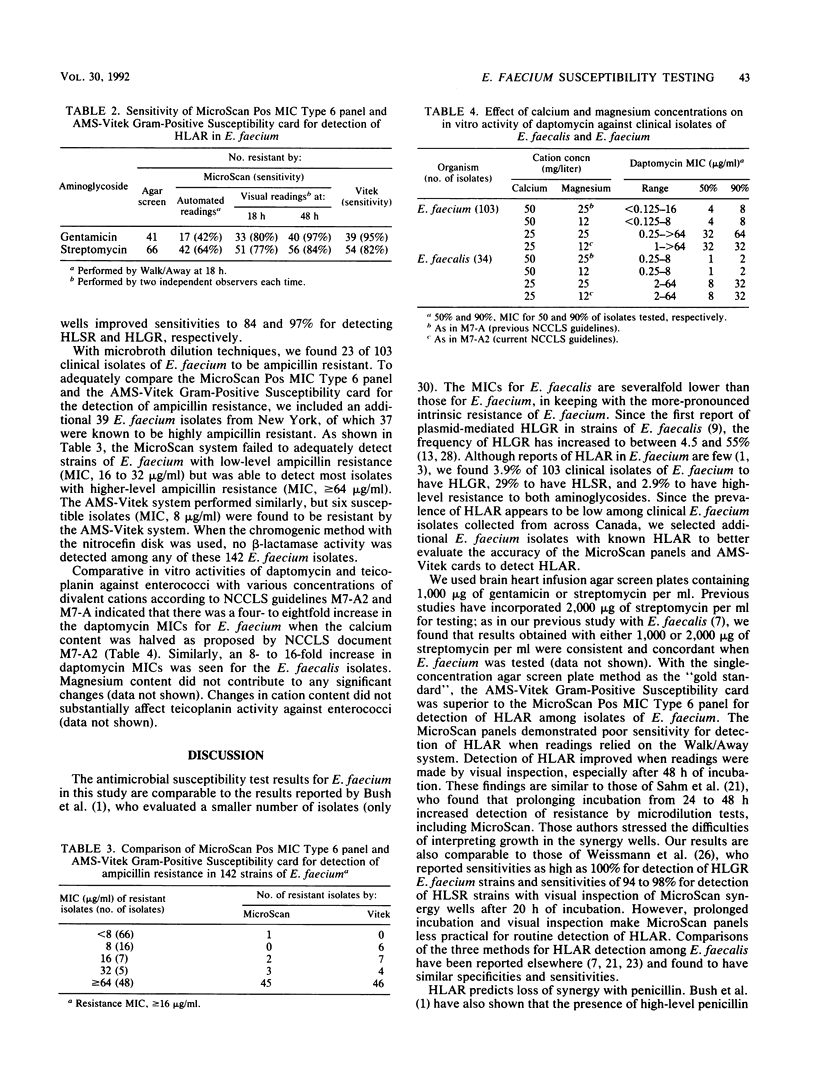
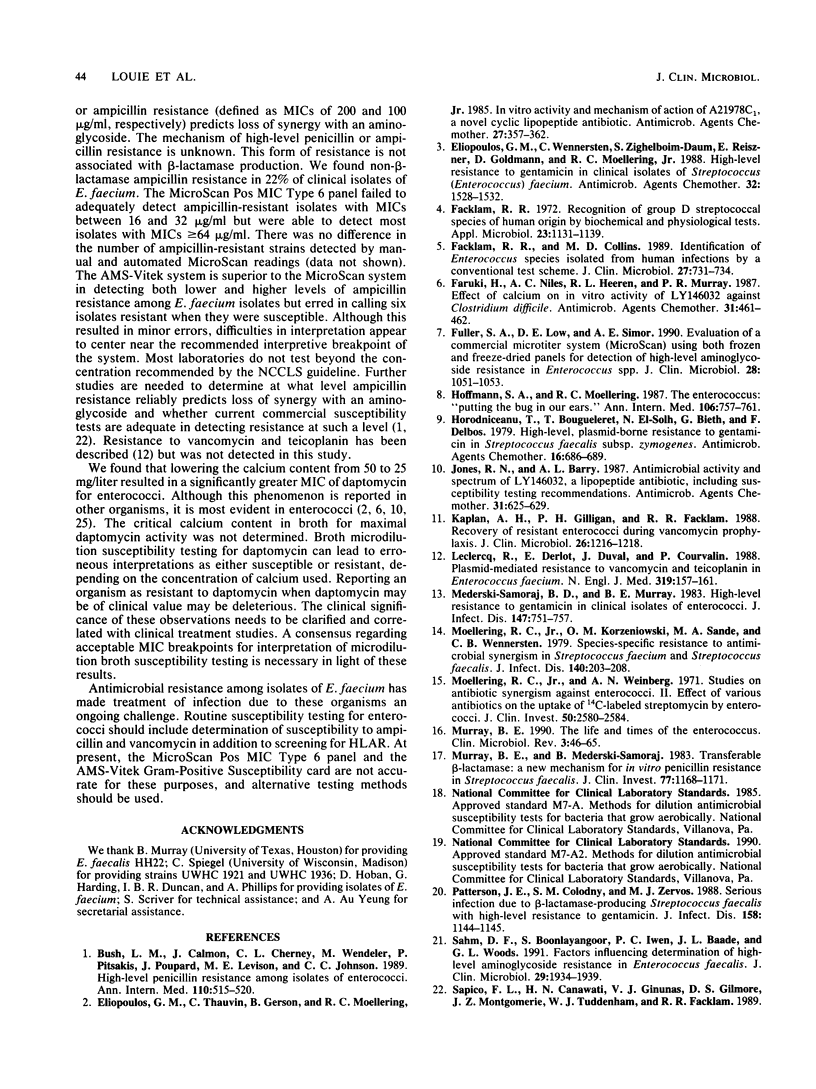
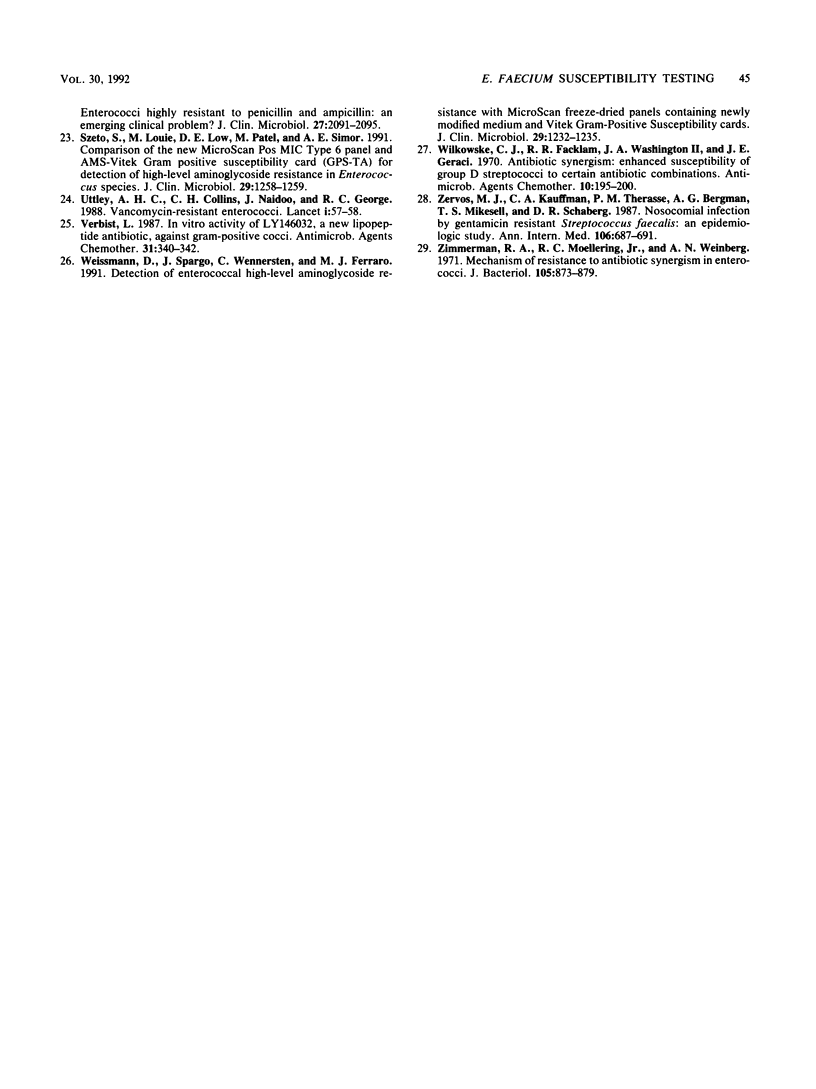
Selected References
These references are in PubMed. This may not be the complete list of references from this article.
- Bush L. M., Calmon J., Cherney C. L., Wendeler M., Pitsakis P., Poupard J., Levison M. E., Johnson C. C. High-level penicillin resistance among isolates of enterococci. Implications for treatment of enterococcal infections. Ann Intern Med. 1989 Apr 1;110(7):515–520. doi: 10.7326/0003-4819-110-7-515. [DOI] [PubMed] [Google Scholar]
- Eliopoulos G. M., Thauvin C., Gerson B., Moellering R. C., Jr In vitro activity and mechanism of action of A21978C1, a novel cyclic lipopeptide antibiotic. Antimicrob Agents Chemother. 1985 Mar;27(3):357–362. doi: 10.1128/aac.27.3.357. [DOI] [PMC free article] [PubMed] [Google Scholar]
- Eliopoulos G. M., Wennersten C., Zighelboim-Daum S., Reiszner E., Goldmann D., Moellering R. C., Jr High-level resistance to gentamicin in clinical isolates of Streptococcus (Enterococcus) faecium. Antimicrob Agents Chemother. 1988 Oct;32(10):1528–1532. doi: 10.1128/aac.32.10.1528. [DOI] [PMC free article] [PubMed] [Google Scholar]
- Facklam R. R., Collins M. D. Identification of Enterococcus species isolated from human infections by a conventional test scheme. J Clin Microbiol. 1989 Apr;27(4):731–734. doi: 10.1128/jcm.27.4.731-734.1989. [DOI] [PMC free article] [PubMed] [Google Scholar]
- Facklam R. R. Recognition of group D streptococcal species of human origin by biochemical and physiological tests. Appl Microbiol. 1972 Jun;23(6):1131–1139. doi: 10.1128/am.23.6.1131-1139.1972. [DOI] [PMC free article] [PubMed] [Google Scholar]
- Faruki H., Niles A. C., Heeren R. L., Murray P. R. Effect of calcium on in vitro activity of LY146032 against Clostridium difficile. Antimicrob Agents Chemother. 1987 Mar;31(3):461–462. doi: 10.1128/aac.31.3.461. [DOI] [PMC free article] [PubMed] [Google Scholar]
- Fuller S. A., Low D. E., Simor A. E. Evaluation of a commercial microtiter system (MicroScan) using both frozen and freeze-dried panels for detection of high-level aminoglycoside resistance in Enterococcus spp. J Clin Microbiol. 1990 May;28(5):1051–1053. doi: 10.1128/jcm.28.5.1051-1053.1990. [DOI] [PMC free article] [PubMed] [Google Scholar]
- Hoffmann S. A., Moellering R. C., Jr The enterococcus: "putting the bug in our ears". Ann Intern Med. 1987 May;106(5):757–761. doi: 10.7326/0003-4819-106-5-757. [DOI] [PubMed] [Google Scholar]
- Horodniceanu T., Bougueleret L., El-Solh N., Bieth G., Delbos F. High-level, plasmid-borne resistance to gentamicin in Streptococcus faecalis subsp. zymogenes. Antimicrob Agents Chemother. 1979 Nov;16(5):686–689. doi: 10.1128/aac.16.5.686. [DOI] [PMC free article] [PubMed] [Google Scholar]
- Jones R. N., Barry A. L. Antimicrobial activity and spectrum of LY146032, a lipopeptide antibiotic, including susceptibility testing recommendations. Antimicrob Agents Chemother. 1987 Apr;31(4):625–629. doi: 10.1128/aac.31.4.625. [DOI] [PMC free article] [PubMed] [Google Scholar]
- Kaplan A. H., Gilligan P. H., Facklam R. R. Recovery of resistant enterococci during vancomycin prophylaxis. J Clin Microbiol. 1988 Jun;26(6):1216–1218. doi: 10.1128/jcm.26.6.1216-1218.1988. [DOI] [PMC free article] [PubMed] [Google Scholar]
- Leclercq R., Derlot E., Duval J., Courvalin P. Plasmid-mediated resistance to vancomycin and teicoplanin in Enterococcus faecium. N Engl J Med. 1988 Jul 21;319(3):157–161. doi: 10.1056/NEJM198807213190307. [DOI] [PubMed] [Google Scholar]
- Mederski-Samoraj B. D., Murray B. E. High-level resistance to gentamicin in clinical isolates of enterococci. J Infect Dis. 1983 Apr;147(4):751–757. doi: 10.1093/infdis/147.4.751. [DOI] [PubMed] [Google Scholar]
- Moellering R. C., Jr, Korzeniowski O. M., Sande M. A., Wennersten C. B. Species-specific resistance to antimocrobial synergism in Streptococcus faecium and Streptococcus faecalis. J Infect Dis. 1979 Aug;140(2):203–208. doi: 10.1093/infdis/140.2.203. [DOI] [PubMed] [Google Scholar]
- Moellering R. C., Jr, Weinberg A. N. Studies on antibiotic syngerism against enterococci. II. Effect of various antibiotics on the uptake of 14 C-labeled streptomycin by enterococci. J Clin Invest. 1971 Dec;50(12):2580–2584. doi: 10.1172/JCI106758. [DOI] [PMC free article] [PubMed] [Google Scholar]
- Murray B. E., Mederski-Samaroj B. Transferable beta-lactamase. A new mechanism for in vitro penicillin resistance in Streptococcus faecalis. J Clin Invest. 1983 Sep;72(3):1168–1171. doi: 10.1172/JCI111042. [DOI] [PMC free article] [PubMed] [Google Scholar]
- Murray B. E. The life and times of the Enterococcus. Clin Microbiol Rev. 1990 Jan;3(1):46–65. doi: 10.1128/cmr.3.1.46. [DOI] [PMC free article] [PubMed] [Google Scholar]
- Patterson J. E., Colodny S. M., Zervos M. J. Serious infection due to beta-lactamase-producing Streptococcus faecalis with high-level resistance to gentamicin. J Infect Dis. 1988 Nov;158(5):1144–1145. doi: 10.1093/infdis/158.5.1144. [DOI] [PubMed] [Google Scholar]
- Sahm D. F., Boonlayangoor S., Iwen P. C., Baade J. L., Woods G. L. Factors influencing determination of high-level aminoglycoside resistance in Enterococcus faecalis. J Clin Microbiol. 1991 Sep;29(9):1934–1939. doi: 10.1128/jcm.29.9.1934-1939.1991. [DOI] [PMC free article] [PubMed] [Google Scholar]
- Sapico F. L., Canawati H. N., Ginunas V. J., Gilmore D. S., Montgomerie J. Z., Tuddenham W. J., Facklam R. R. Enterococci highly resistant to penicillin and ampicillin: an emerging clinical problem? J Clin Microbiol. 1989 Sep;27(9):2091–2095. doi: 10.1128/jcm.27.9.2091-2095.1989. [DOI] [PMC free article] [PubMed] [Google Scholar]
- Szeto S., Louie M., Low D. E., Patel M., Simor A. E. Comparison of the new MicroScan Pos MIC Type 6 panel and AMS-Vitek Gram Positive Susceptibility Card (GPS-TA) for detection of high-level aminoglycoside resistance in Enterococcus species. J Clin Microbiol. 1991 Jun;29(6):1258–1259. doi: 10.1128/jcm.29.6.1258-1259.1991. [DOI] [PMC free article] [PubMed] [Google Scholar]
- Uttley A. H., Collins C. H., Naidoo J., George R. C. Vancomycin-resistant enterococci. Lancet. 1988 Jan 2;1(8575-6):57–58. doi: 10.1016/s0140-6736(88)91037-9. [DOI] [PubMed] [Google Scholar]
- Verbist L. In vitro activity of LY146032, a new lipopeptide antibiotic, against gram-positive cocci. Antimicrob Agents Chemother. 1987 Feb;31(2):340–342. doi: 10.1128/aac.31.2.340. [DOI] [PMC free article] [PubMed] [Google Scholar]
- Weissmann D., Spargo J., Wennersten C., Ferraro M. J. Detection of enterococcal high-level aminoglycoside resistance with MicroScan freeze-dried panels containing newly modified medium and Vitek Gram-Positive Susceptibility cards. J Clin Microbiol. 1991 Jun;29(6):1232–1235. doi: 10.1128/jcm.29.6.1232-1235.1991. [DOI] [PMC free article] [PubMed] [Google Scholar]
- Wilkowske C. J., Facklam R. R., Washington J. A., 2nd, Geraci J. E. Antibiotics synergism: enhanced susceptibility of group D streptococci to certain antibiotic combinations. Antimicrob Agents Chemother (Bethesda) 1970;10:195–200. [PubMed] [Google Scholar]
- Zervos M. J., Kauffman C. A., Therasse P. M., Bergman A. G., Mikesell T. S., Schaberg D. R. Nosocomial infection by gentamicin-resistant Streptococcus faecalis. An epidemiologic study. Ann Intern Med. 1987 May;106(5):687–691. doi: 10.7326/0003-4819-106-5-687. [DOI] [PubMed] [Google Scholar]
- Zimmermann R. A., Moellering R. C., Jr, Weinberg A. N. Mechanism of resistance to antibiotic synergism in enterococci. J Bacteriol. 1971 Mar;105(3):873–879. doi: 10.1128/jb.105.3.873-879.1971. [DOI] [PMC free article] [PubMed] [Google Scholar]


